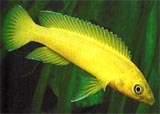Natural Habitat:
rocky shores in deep
water;
benthopelagic, freshwater;
pH
range: 7.5 - 8.0; dGH range: 12.0 - 15.0.
Climate: tropical; 24 - 26°C; 6°S - 9°S. Usually found in
the
recesses of the biotope, but will swim in open water.
Conservation Status: Not in IUCN Red List.
Threats: Unknown.
Size: Adults
are 8.0 to 13.0 cm in an aquarium environment; males larger than
females.
Water Requirements: Hard and alkaline,
with a
pH 7.8 - 8.0 and a dGH
12 - 15. Temperature between 25-26
oC.
Tank Habitat: Sandy substrate with rock
cover and stable, rocky caves.
Diet: N. leleupi readily accept
most foods--flakes, frozen and live. A combination of foods is
recommended.
Sexing: Difficult: males and females have
an identical appearance. Males attain a larger size.
Reproduction: dioecism; guarders /
tenders;
N. leleupi is a substrate spawner and is regarded as a monogamous
cichlid.
The female will lay eggs in a cave or crevice and the male guards the
territory.
Once hatched and free swimming, the young are closely guarded by the
female.
Pair formation is reputedly difficult to achieve. My breeding
pair
self-selected from a community of eight fish.
Tank Community: Territorial and very
aggressive
for a small fish.
N. leleupi can be kept with a variety
of
different dwarf Lake Tanganyikan cichlids, with the exception of larger
cichlids and piscivores. As they are somewhat aggressive and can take
care
of themselves in most situations. Both sexes are aggressive
against
their own kind and are best kept one pair only to a tank. Specimens
will
swim in and around rocks as well as through open water.
Incompatible Species: Larger
cichlids.
Comments:
Rock dweller.
Neolamprologus leleupi longier is a colour
variant
of this species, being brilliant orange-yellow.
I have never seen any offered for sale in Sth Australia under this
name, however German bred yellows are available. Most juvenile
specimens
offered for sale are bright yellow but turn yellow-brown in my tank
!
My breeding pair is olive-yellow, with black marking around the face
and
mouth, They breed in an up-turned broken flower pot that is
hidden
beneath rocks. They dig a hollow in the substrate (quartz sand
with
10% coral sand) so that the entrance to the brooding area is behind its
own little sand dune. The fry are tolerated by other generations
of the species and survival rate is high if fed on brine shrimp and
powdered
Tetra Bits.
 It
is my experience that not all Lemon Cichlids remain this colour as
adults.
It
is my experience that not all Lemon Cichlids remain this colour as
adults.
 It
is my experience that not all Lemon Cichlids remain this colour as
adults.
It
is my experience that not all Lemon Cichlids remain this colour as
adults.